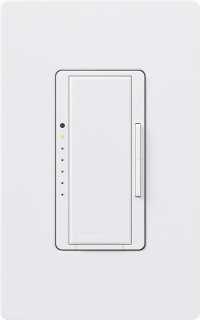Energy Tip 6 - Dimbat
By quixjote on Jan 29, 2011 | In Uncategorized, Saving Money | 2 feedbacks »
 I thought about this article the other day when I was over at my Grandmother's house. I looked up at her lights and saw that there were quite a few cobwebs in the cans of her vaulted ceiling. The bulbs were off at the moment so I could see that they were just the generic Sylvania 65W Bulbs. I had forgotten that her lights were all on dimmers in the main room.
I thought about this article the other day when I was over at my Grandmother's house. I looked up at her lights and saw that there were quite a few cobwebs in the cans of her vaulted ceiling. The bulbs were off at the moment so I could see that they were just the generic Sylvania 65W Bulbs. I had forgotten that her lights were all on dimmers in the main room.
Since the 70's, most of the switch dimmers have switched over to electronic dimers. Before this point the most common dimmer was the electric rheostat dimmer, which other than dimming the bulb, did not offer any electric savings. In fact, all they did was change the electricity into heat.
The electronic dimmers however, have enormous savings potential. Especially if you are like me and don't always need the light to be at maximum output, you can save a lot, both in usage, and in bulb costs. Basically what the newer dimmers do is increases the delay in the amount of time that the current is actually getting to the light bulb. This happens so fast however that (especially on an incandescent bulb) we do not even notice it.
What does this mean? Well for incandescent bulbs, it means that (according to who you read or follow) if you dim the lights by 25% you will save roughly 20% of the electricity, and increase the life of the bulb by up to a factor of 4, especially if your dimmer goes from off-dim-on. This would explain why cobwebs have been able to form in my Grandmother's lights.
Unfortunately, Compact Florescent Bulbs do not all take advantage of dimming, and those that do, do not do so very well, and can even cause life shortage in CFL bulbs. Newer LED bulbs have been showing some promise with dimming though, having close to the full dimming range as incandescent bulbs.
Email [email protected] for details.
2 comments
What they do is reduce the voltage to the bulb, which reduces the current through it. Voltage x Current = Wattage. So when a rheostat cuts the voltage to the bulb by 50% the current is reduced to 50% as well, resulting in 1/4 the power usage at the bulb and 1/4 at the rheostat for a 50% savings. Thus a 100-watt bulb would use 25 watts at the bulb and 25 watts at the rheostat, at this setting.
50% voltage is the worst case for the poor rheostat in terms of heating up, so the picture is rosier at higher or lower settings, in terms of wasted heat at the rheostat.
At the lowest load, you get the brightest light, but as the energy has to pass through a larger resistance, you see less light, but you get minimal difference on the source end.
If you want an experiment, hook a meter up to even a battery powered light source on a potentiometer. Hook the meter up both before and after the potentiometer. You will find that the power that goes from the potentiometer to the light will be less, but the power being drawn from the source TO the potentiometer will be almost the same. After time you will also notice that your potentiometer will start to get warm ;)
No, where the savings come in is the TRIAC based electronic dimmer. they literally toggle the power (Literally turn off and on) to the light source at a rate fast enough to that we can see a solid light, but at a variable control to allow us determine (how long) the bulb is turned on.
We do not see the results because on the light side of the TRIAC there is usually up to a 100nF capacitor that is used for discharge for those short moments when the TRIAC is switched to off.
| « Google's Decision | Energy Tip 5 - A Watched Pot » |



